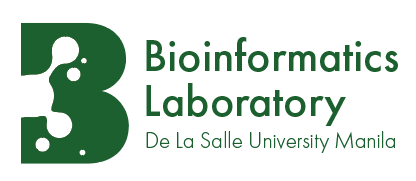Introduction to Bioinformatics#
Instructor#
Anish M.S. Shrestha
Bioinformatics Lab,
AdRIC, DLSU Manila
www.bioinfodlsu.com
www.a-transposable-element.com
Errors, concerns, issues, questions? Please contact: anish.shrestha –atmark– dlsu.edu.ph or raise an issue at GitHub by following the GitHub link at the top of this and every other page of this document.
Course Description#
Modern biology relies on a host of experimental techniques which shed light into a variety of phenomena that come together to constitute this amazing thing we call “life”. These experiments generate massive amounts of data, most of which are in the form of sequences. Making sense of these sequences requires, apart from a keen understanding of biology, the ability to employ a range of tools from the arsenal of computer science, mathematics, and statistics. In this course, we will explore the basic computational techniques for biological sequence analysis.
Target Audience#
This is an introductory course in bioinformatics offered periodically as an elective course to higher undergraduates or early graduate computer science students at DLSU-Manila.
The material is targeted towards students from a computational discipline who have taken foundational courses in algorithms or programming, or probability and statistics, etc, and who have interest in biology.
Learning outcomes#
At the end of the course, the student is expected to be able to do the following:
Describe basic biological processes and how these can be studied using computational tools.
Explore publicly available databases for genomic, transcriptomic, proteomic data.
Describe the core idea behind algorithms foundational bioinformatics algorithms and models.
Choose from the many sequence analysis algorithms and software tools and apply them to publicly available biological data to answer questions about sequence evolution.
Learning Plan#
Week |
Topic |
|---|---|
1 |
Introduction |
2 |
Module 1: The very basics of molecular biology of the cell |
3 |
Module 2: Exploration of our genome |
4 |
Module 3: Genome annotation and hidden Markov models |
5 |
Student presentations and discussions on Module 1,2 |
6 |
Module 4: Sequence evolution and sequence alignment |
7 |
Module 5: Faster and more refined sequence alignment |
8 |
Student presentations and dicussions on Module 3,4 |
9 |
Module 6: Multiple sequence alignment and profile HMMs |
10 |
Module 7: Phylogenetic tree estimation |
11 |
Student presentations and discussion on Module 5,6 |
12 |
Module 8: Genome-wide association studies |
13 |
Module 9: Measuring and comparing gene expression |
14 |
Student presentations and discussions on Module 7,8 |
Major course output#
Each module has a hands-on component. Students are required to submit a report along with source code, for example in Jupyter/Colab Notebook/ R Markdown format.
Reference Material#
This online ‘’book’’ contains notes for each module. It is meant to be a scaffold, providing structure to the course, and not meant to be comprehensive. Please read reference material and link-outs provided in each module for a more detailed treatment. For scientific articles behind paywalls, you might want to search the libary of the ‘’emancipator and democratiser of knowledge’’.
A comprehensive textbook for bioinformatics is hard to come by, since the field is moving rapidly and students have varying backgrounds. Even so, here are some good books to learn the foundational concepts in bioinformatics and biology.
Bioinformatics#
R. Durbin, S. Eddy, A. Krogh, G. MitchisonB. (1998). Biological Sequence Analysis. Probabilistic models of proteins and nucleic acids. Cambridge University Press.
Warren Ewens and Gregory Grant. (2001). Statistical Methods in Bioinformatics: An Introduction. Springer.
Biology#
T.A. Brown, (2023) Genomes 5, CRC Press (or earlier editions)
An online version of the 2nd edition is available here: https://www.ncbi.nlm.nih.gov/books/NBK21128/
Bruce Alberts, Alexander Johnson, Julian Lewis, Martin Raff, Keith Roberts, and Peter Walter, (2024) Molecular Biology of the Cell, 7th edition, W.W. Norton & Company (or earlier editions)
An online version of the 4th edition is available here: https://www.ncbi.nlm.nih.gov/books/NBK21054/
Alberts, Heald, Hopkin, Johnson, Morgan, Roberts, Walter, (2023) Essential Cell Biology Sixth Edition, W.W. Norton (or earlier editions)
